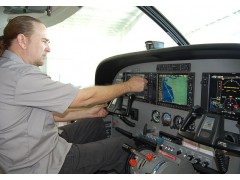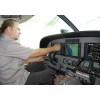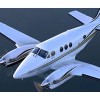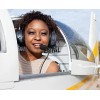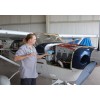Do you have your private pilot’s license and are ready to earn your instrument rating? Here at Universal Flight Training we can help. Our dependable new Cessna aircraft are well equipped with cutting edge technology in the cockpit to make your instrument training a relaxed, enjoyable and thrilling experience.As a private pilot, you will quickly acknowledge the limitations of your training and privileges. Non- instrument rated pilots may only operate airplanes in weather conditions that allow continuous visual contact with the ground, keep the airplane a specified distance from clouds (depending on the airspace the flight is conducted in) and have certain minimum ceiling and visibility requirements (again, dependent upon the airspace).
In very simple terms, the Instrument Rating allows pilots to safely fly in and through clouds. This can be extremely helpful to being able to complete a flight safely and efficiently. Even if you don’t anticipate conducting flights in ‘bad weather’, the instrument rating is a wonderful tool for cross country flying within the airway system.
Instrument Rated pilots are safer, more precise in their flying and adherence to procedures and statistically less likely to be involved in an aviation accident.
Requirements for an instrument rating:
Hold at least a private pilot certificate.
Be able to read, write, and converse fluently in English.
Hold a current FAA medical certificate.
Receive and log ground training from an authorized instructor and/or complete a home-study on-line course that comes with your Instrument Training Kit . Other excellent resources for your instrument training will include: the invaluable Jeppesen Instrument/Commercial Manual, the FAA’s Instrument Procedures Handbook and Instrument Flying HandbookSubjects include:FARs
IFR-related items in the AIM
ATC system and procedures
IFR navigation
Use of IFR charts
Aviation weather
Operating under IFR
Recognition of critical weather
Aeronautical Decision Making (ADM)
Crew Resource Management (CRM)
Pass the FAA instrument rating knowledge test with a score of 70% or better.
Accumulate flight experience (FAR 61.65): 50 hr. of cross-country flight time as pilot in command, of which at least 10 hr. must be in airplanes: The 50 hr. includes solo cross-country time as a student pilot, which is logged as pilot-in-command time.
Each cross-country must have a landing at an airport that was at least a straight-line distance of more than 50 NM from the original departure point.
A total of 40 hr. of actual or simulated instrument time in the areas of operation listed in7. below, including: 15 hr. of instrument flight training from a CFII (CFII is an instructor who is authorized to give instrument instruction) days preceding the practical test
Cross-country flight procedures that include at least one cross-country flight in an airplane that is performed under IFR and consists of: A distance of at least 250 NM along airways or ATC-directed routing
An instrument approach at each airport
Three different kinds of approaches with the use of navigation systems
If the instrument training was provided by a CFII, a maximum of 20hr. may be accomplished in an approved flight simulator or flight training device.
Use our Instrument Training Kit from your first flight lesson to your practical test. We outline and illustrate each flight maneuver you will perform during your flight training and explain the common errors associated with each flight maneuver.
Demonstrate flight proficiency (FAR 61.65). You must receive and log training, as well as obtain a logbook sign-off (endorsement) from your CFII on the following areas of operation: Preflight preparation
Preflight procedures
Air traffic control clearances and procedures
Flight by reference to instruments
Navigation systems
Instrument approach procedures
Emergency operations
Post flight procedures
Successfully complete the instrument rating practical test, which will be conducted as specified in your Instrument Training Kit.

